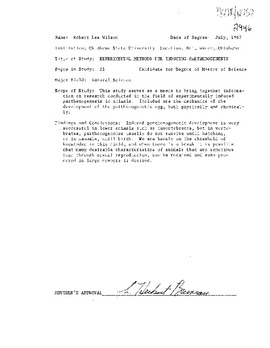| dc.contributor.advisor | Bruneau, L. Herbert | |
| dc.contributor.author | Wilson, Robert Lee | |
| dc.date.accessioned | 2016-01-27T22:26:50Z | |
| dc.date.available | 2016-01-27T22:26:50Z | |
| dc.date.issued | 1967-07 | |
| dc.identifier.uri | https://hdl.handle.net/11244/26938 | |
| dc.description.abstract | Scope and Study: This study serves as a means to bring together information on research conducted in the field of experimentally induced parthenogenesis in animals. Included are the mechanics of the development of the parthenogenetic egg, both physically and chemically. | |
| dc.description.abstract | Findings and Conclusions: Induced parthenogenetic development is very successful in lower animals such as invertebrates, but in vertebrates, parthenogenones usually do not survive until hatching, or in mammals, until birth. We are barely on the threshold of knowledge in this field, and when there is a break it is possible that many desirable characteristics of animals that are sometimes lost through sexual reproduction, can be retained and even produced in large numbers if desired. | |
| dc.format | application/pdf | |
| dc.language | en_US | |
| dc.rights | Copyright is held by the author who has granted the Oklahoma State University Library the non-exclusive right to share this material in its institutional repository. Contact Digital Library Services at lib-dls@okstate.edu or 405-744-9161 for the permission policy on the use, reproduction or distribution of this material. | |
| dc.title | Experimental methods for inducing parthenogenesis | |
| dc.contributor.committeeMember | Drew, William A. | |
| osu.filename | Thesis-1967R-W752e.pdf | |
| osu.accesstype | Open Access | |
| dc.type.genre | Master's Report | |
| dc.type.material | Text | |
| thesis.degree.discipline | Natural Science | |
| thesis.degree.grantor | Oklahoma State University | |
